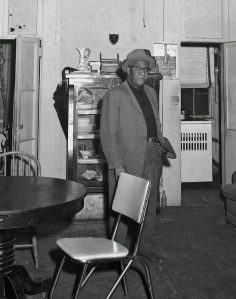On March 27, 1962—the day news of the state appropriation became public—Knick News reporters Kurt Wachenheim and Edward Swietnicki walked the streets of Albany’s 98 acres to gauge public opinion. What they found was a mix of “elation, indifference, disappointment, and hope.”

As a group, small business owners were particularly upset by the news. The proprietor of the Busy Corner Grocery on Hudson and S. Swan since 1937, Samuel Bucca “turned ashen … and was unable to speak for a moment.” When he finally found his voice, he said, “This stinks. I could say some few choice words, believe me. Why didn’t they carry out their original intent to stay on the campus? ….. It’s a tremendous area, far more than I thought they’d take.”
Four short blocks away at 53 High, the response was very different. Louise Sim lived with her husband Harry in a house owned by her parents, Antonio and Filamena Palumbo. She had grown up on High Street but was ready to move, “This section was nice once, but it has deteriorated so much. This is a good excuse to get out of it.”

Down Hamilton to Grand Street, the reporters spoke with a group of men, who believed—or at least hoped—that redevelopment would mean progress. John Johnson, of 31 Grand, said, “These houses are old. I think it would be swell to tear these buildings down.” His next-door neighbor, James Strawn agreed, demolishing “these 50-and-60 year old buildings might make for some decent places in which to live.” George Kemp Jr. added, “This would be a pretty good deal if they included housing projects too.”
For some, it was an opportunity to move on, but for the business owners who had put their lives into their small businesses, the coming demolition must have felt like a death knell. Were they fairly compensated for their losses? What happened to them, I wonder.
LikeLiked by 1 person
Good question. We’re not yet sure what happened to everyone. But we do plan to track everyone we can into their new homes. Due to discrimination, finding a new place to live was probably hardest for African American tenants, like James Strawn, George Kemp, and John Johnson.
LikeLiked by 1 person
Thanks for getting back to me. Good luck with your search!
LikeLiked by 1 person